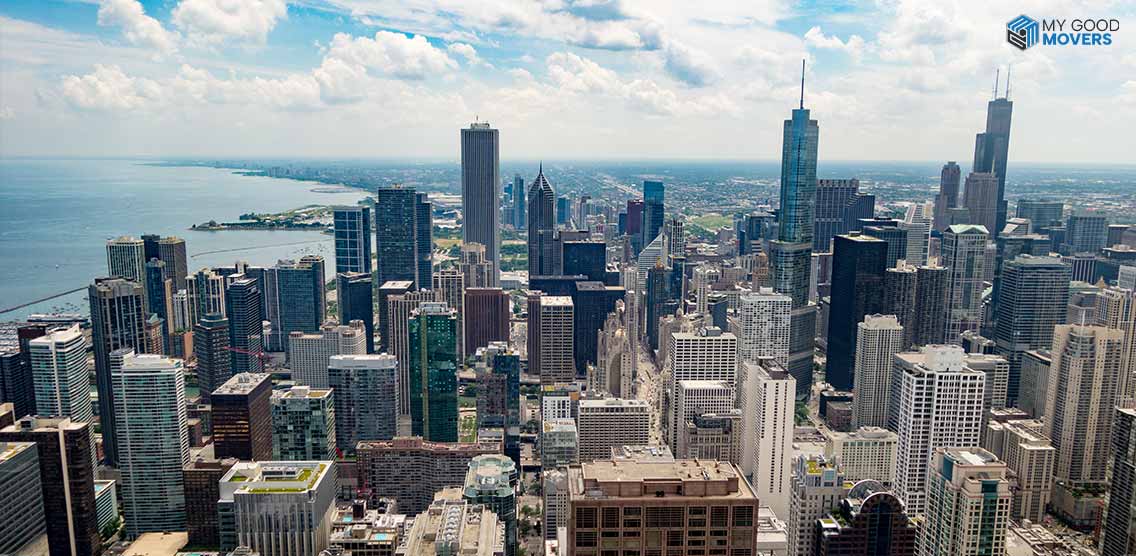Chicago is an October sort of city, even in spring.
When people talk about moving to Chicago, they often imagine the skyline, the deep-dish pizza, and maybe even the bustling energy of the Magnificent Mile.
However, as the saying suggests, Chicago has a way of being unforgettable, no matter the season.
If you are thinking of moving to Chicago, then there are some key factors to keep in mind that go beyond famous landmarks.
Chicago is the third-largest city in the United States, with a population of nearly 2.7 million. It offers a diverse range of neighborhoods, industries, and lifestyles.
The city has consistently been ranked among the top places for job opportunities.
However, it’s not just about the job market. Cost of living in Chicago is 20-30% higher than the national average.
The rent for a one-bedroom apartment downtown ranges from $1,800 to $2,100 monthly. This makes budgeting a critical part of your move.
Moreover, Chicago is infamous for its winters. On average, the city gets about 36 inches of snow annually, and temperatures can drop as low as 10°F (-12°C).
But don’t let that scare you—Chicago is also home to one of the country’s most reliable public transit systems.
In this blog, we’ll discuss everything you need to know before your move to Chicago.
Curious about your moving costs? Fill out the details, and we’ll calculate them for you.
Free Instant Quote
Fields marked with an * are required
Chicago is more than just a relocation—it’s the beginning of a grand adventure!
Best Neighborhoods in Chicago for Families
If you are moving to Chicago with your family, it is crucial to pick the right neighbourhood.
Chicago has over 200 distinct neighbourhoods, each with its own charm, but not all are equally suited for families.
Let's see some of the best neighbourhoods in Chicago for families.
Lincoln Park
Lincoln Park is one of Chicago's most desirable neighbourhoods for families—and for a good reason.
It offers plenty of green space, playgrounds, and the famous Lincoln Park Zoo (which is free!).
The area also has excellent schools like Lincoln Park High School and St. Clement School,
The average rent for a one-bedroom apartment in Lincoln Park is around $1,800.
If you’re looking to buy a home here, it typically ranges from $485,000 to well over a million.
Lakeview
Lakeview offers a slightly more affordable option while still being close to the lake.
It is known for its lively yet family-friendly atmosphere. It has a diverse mix of restaurants, parks, and entertainment options like Wrigley Field.
Families can benefit from its top-rated schools like Blaine Elementary School and Hawthorne Scholastic Academy.
You’ll find a variety of housing options, with the average rent for a one-bedroom apartment around $1,695 and home prices ranging from $400,000 to $900,000.
Edison Park
Edison Park is a hidden gem for families. It is located on the far northwest side of Chicago.
Edison Park has some of the city’s safest streets and top-notch public schools, like Ebinger Elementary and Edison Park Elementary.
It's a quiet neighbourhood with tree-lined streets, large single-family homes, and easy access to nearby suburbs.
One of the key advantages of Edison Park is its affordability compared to other family-friendly neighbourhoods.
The average home price is around $300,000, and there are fewer rental options.
Beverly
Beverly is located on the city’s southwest side and offers a unique blend of urban and suburban living.
It is known for its spacious homes and large yards; this neighbourhood has a rich history and a tight-knit community.
Beverly is particularly appealing to families because of its strong local schools, such as Sutherland Elementary School and Morgan Park Academy.
What sets Beverly apart is its affordability for families looking for larger homes.
The median home price here is around $350,000, and you’ll find beautiful historic houses with plenty of space for kids to play.
Oak Park
Oak Park isn’t technically in Chicago, but it’s close enough (about 10 miles west of downtown) and too good not to mention.
It is known for its excellent schools and a strong sense of community.
Oak Park is one of the best suburbs for families moving to the Chicago area.
The public school system, like Oak Park-River Forest High School, consistently ranks among the top in Illinois.
Housing prices in Oak Park are a bit higher than in some Chicago neighbourhoods.
The average home price ranges around $400,000.
Chicago Job Market for Newcomers
One of the most important things to consider—especially if you're a newcomer or a young professional—is the job market.
With a population of nearly 2.7 million people, Chicago is the third-largest city in the U.S.
It offers a wealth of opportunities for job seekers of all backgrounds.
Key Industries in Chicago
Chicago’s economy is built on a solid foundation of diverse industries.
Here are some major sectors:
Finance: Chicago is a major financial hub. It is home to the Chicago Stock Exchange, CME Group (Chicago Mercantile Exchange), and various multinational banks.
Healthcare: The healthcare industry is expanding rapidly here. Institutions like Northwestern Memorial Hospital and Rush University Medical Center are employing thousands.
Technology: Tech is one of the fastest-growing sectors in Chicago.
The city is often seen as a rising tech hub due to the companies like Grubhub, Groupon, and Salesforce.
Manufacturing and Logistics: Chicago’s central location is known for its logistics powerhouse.
Major companies like Caterpillar, Kraft Heinz, and Boeing have a strong presence in the area.
Education: Chicago also has prestigious institutions like the University of Chicago and Northwestern University, which provide ample opportunities in education and research.
Employment Rate and Salary Expectations
As of the latest data, the unemployment rate in Chicago is around 3.2%, which is lower than the national average.
For newcomers, this is a positive sign that opportunities are available across various sectors.
In terms of salaries, the median income for an individual in Chicago is about $60,000 per year. However, your salary will vary based on your industry and experience.
| Industry | Average Salary |
|---|---|
| Finance | $75,000 - $120,000 |
| Healthcare | $60,000 - $85,000 |
| Technology | $80,000 - $130,000 |
| Education | $50,000 - $75,000 |
| Manufacturing | $50,000 - $70,000 |
| Logistics | $45,000 - $70,000 |
Job Opportunities for Entry-Level Professionals
If you are just starting out, don’t worry—Chicago is a city of opportunities for newcomers.
You will easily find tons of internships and trainee programs in larger corporations.
Tech Jobs: Entry-level positions like Junior Software Developer or IT Support Specialist can pay between $60,000 and $80,000 annually.
Healthcare: Entry-level positions such as Registered Nurse (RN) can start around $65,000 annually.
Finance and Consulting: If you’re leaning towards finance or consulting, expect starting salaries around $55,000 to $75,000.
Major Employers in Chicago
Chicago is home to numerous Fortune 500 companies as well as fast-growing startups.
Some of the largest employers in the city include:
Boeing: Boeing is one of the largest aerospace companies in the world, with many roles in engineering, finance, and operations.
McDonald’s: The global fast-food giant's headquarters are here. The company offers opportunities in corporate strategy, marketing, and operations.
Allstate is one of the largest insurance companies in the U.S., and it offers roles in finance, insurance, and customer service.
AbbVie: It is a leading biopharmaceutical company that frequently hires for roles in research, development, and sales.
Chicago Public Transportation Guide
If you are moving to Chicago, one of the most important things to understand is how to get around.
Let’s discuss how Chicago’s public transportation works.
The CTA
The Chicago Transit Authority (CTA) runs the city's bus and train systems
It provides coverage across the city and its nearby suburbs.
The CTA serves more than 1.6 million riders daily across its various services.
Here’s a breakdown of how the CTA operates:
"L" Train: The CTA’s rail system, known as the "L" (short for "elevated"), is the most iconic part of Chicago’s transit network.
It consists of eight color-coded lines. The train lines are reliable and frequently run 24/7.
CTA Bus: "L" trains are over 130 bus routes that crisscross the city. It covers corner that the trains don’t.
The "L" Train System
The "L" trains are the most popular way to get around the city.
Each line is color-coded, which makes it easy to follow.
| Train Line | Key Destinations | Operating Hours |
|---|---|---|
| Red Line | Runs north-south, connecting Rogers Park to Chinatown and 95th/Dan Ryan | 24 hours |
| Blue Line | Connects O'Hare Airport to downtown and the western suburbs | 24 hours |
| Green Line | Runs from Oak Park to South Side neighborhoods like Englewood | 4:00 AM - 1:00 AM |
| Brown Line | Serves northern neighborhoods like Lincoln Park and Lakeview | 4:00 AM - 1:30 AM |
| Orange Line | Connects Midway Airport to the Loop | 4:00 AM - 1:00 AM |
| Purple Line | Primarily a commuter route between downtown and Evanston | Peak hours (weekday rush only) |
| Pink Line | Runs from the west side to downtown | 4:00 AM - 1:00 AM |
| Yellow Line | Connects suburban Skokie to the northern part of the city | Peak hours (weekday rush only) |
The Red and Blue lines run 24/7, which is particularly handy for late-night travel.
CTA Buses
If the train system doesn’t take you exactly where you need to go, the CTA’s bus system will.
Buses cover virtually all areas. There are over 130 bus routes, and many run parallel to the train lines.
Main Bus Routes: Major roads like Michigan Avenue, State Street, and Ashland Avenue are well-served by buses, with frequent stops and short wait times.
Express Services: Some routes also offer express services, which skip certain stops to shorten travel time during rush hours.
A bus ride costs $2.50 with a Ventra card (CTA’s payment system)
Fares and Payment Options
Chicago has simplified its fare system with Ventra cards, which can be used on both buses and trains.
| Fare Type | Cost |
|---|---|
| Single Ride | $2.50 (bus), $2.50 (train) |
| Transfer | $0.25 (within 2 hours) |
| Monthly Pass | $105 (unlimited rides) |
| 1-Day Pass | $5 |
| 7-Day Pass | $20 |
Use the Metra for Suburban Commutes
Metra is a commuter rail system that connects Chicago to its suburbs and beyond.
It serves more than 240 stations.
It’s perfect for those who want to avoid long commutes in traffic.
| Metra Line | Key Destinations | Peak Fare |
|---|---|---|
| BNSF Railway | Runs between Aurora and Chicago’s Union Station | $5.50 - $10.00 |
| UP-North | Connects Kenosha (WI) to downtown Chicago | $5.00 - $9.50 |
| UP-West | Runs from Elburn to Chicago | $5.50 - $10.00 |
| Metra Electric | Serves Hyde Park and the South Side | $3.25 - $6.75 |
Commuting Tips for Chicago
Here are a few tips to make your commute easier:
Rush Hours: Chicago’s rush hours typically run from 7 AM - 9 AM and 4 PM - 6 PM, especially on the “L” and Metra lines.
Ventra App: Download the Ventra app to manage your card, check balances, and reload fares.
Biking and Transit: Chicago has a strong biking culture, and you can easily combine biking with public transit. The city also offers a bike-share program called Divvy.
How Much Will It Cost to Move to Chicago?
Let’s discuss how much will it cost you to move to Chicago.
Moving Costs
The cost of moving to Chicago depends on where you are coming from, how much stuff you are bringing, and the type of moving services you choose.
Local Move (within 100 miles): If you are moving locally, ready to pay between $800 and $2,200.
Long-Distance Move: If you are moving from another state, the cost jumps significantly. For a 1,000-mile move, it can range from $2,000 to $5,500.
DIY Move: If you prefer to handle the move yourself, renting a moving truck will cost around $1,200 to $2,500. Don’t forget to factor in gas, which can add another $200 to $400.
Housing Costs
Once you’ve moved, you’ll need a place to live, and housing costs in Chicago can vary significantly by neighborhood.
Here's a quick breakdown of typical rent costs:
| Neighborhood | Average Rent (1BR) | Average Home Price |
|---|---|---|
| The Loop | $2,100 | $500,000+ |
| Lincoln Park | $1,800 | $485,000 |
| Lakeview | $1,695 | $400,000 |
| Edgewater | $1,450 | $280,000 |
| Portage Park (suburb) | $1,200 | $300,000 |
Utilities and Monthly Expenses
It is important to factor in utilities, groceries, and other monthly expenses. These costs are often overlooked, but they add up.
Here’s a snapshot of monthly expenses:
| Expense | Cost (per month) |
|---|---|
| Utilities | $150 - $180 |
| Internet | $60 - $80 |
| Groceries | $300 - $400 |
| Public Transit Pass | $105 |
| Parking (if you own a car) | $200 - $400 |
Additional Costs
There are also additional costs to consider when moving to Chicago, such as:
| Item | Cost |
|---|---|
| Utilities | $150 - $180 |
| Security Deposit | 1 month’s rent |
| Move-in Fees | $200 - $500 |
| Furniture (new home) | $3,000 - $5,000 |
| Renters/Home Insurance | $20 - $100/month |
Total Estimated Moving Costs
Moving to Chicago can range from $4,000 to $15,000 when you add it all up.
| Expense Category | Estimated Cost Range |
|---|---|
| Moving Services (long-distance) | $2,000 - $5,500 |
| Housing (first month’s rent or mortgage) | $1,500 - $5,000 |
| Utilities (first month) | $150 - $180 |
| Furniture/Setup | $3,000 - $5,000 |
| Security Deposit/Move-in Fees | $200 - $500 |
| Total Estimated Cost | $4,000 - $15,000+ |
Moving Tips for Chicago in Winters
If you’re moving to Chicago in the winter, brace yourself—this city is known for its intense cold, snow, and wind.
But with the right preparation, your move can go smoothly, and you’ll settle into your new home without too many hiccups.
Hire Movers
Moving in snowy, icy conditions isn’t something to take lightly, especially if you're not used to handling cold weather.
Hiring professional movers with experience in Chicago winters can help you in your move.
Many moving companies in Chicago offer special winter moving packages, so check in advance.
Some companies offer discounts of up to 20-30% compared to summer moves.
Keep an Eye on the Weather Forecast
One of the trickiest parts of moving to Chicago during winter is the unpredictability of the weather.
Blizzards and snowstorms can pop up out of nowhere.
About 22 snowstorms occur annually in Chicago, with severe conditions possible in January and February.
Plan to be flexible with your schedule. If a big storm is expected on your moving day, it’s best to reschedule.
Prepare Your New Home for Winter Moving
When moving during Chicago's cold season, you need to make sure your new home is ready for the weather.
Turn on the heat a few days before your move, if possible.
Lay down plastic sheets or tarps at the entrances to protect the floors from snow, ice, and salt.
Make sure the sidewalks and driveways are clear of ice and snow.
Pack Smart for the Cold
Packing in the winter isn’t the same as during warmer months.
Cold temperatures and moisture can damage your belongings if they aren’t packed properly.
Use plastic bins instead of cardboard boxes for fragile items.
Pack a winter essentials box. Moving in the cold means you’ll want easy access to items like gloves, hats, scarves, and even hot drinks like thermoses of coffee or tea.
Don’t forget to pack winter supplies such as ice scrapers, salt, and shovels.
Watch Out for Parking Restrictions
Chicago has strict winter parking rules that can catch new residents off guard.
From December 1 to April 1, overnight parking is banned on certain streets when snow accumulates to 2 inches or more.
Make sure you know the parking restrictions in your area before you park anything on the street.





